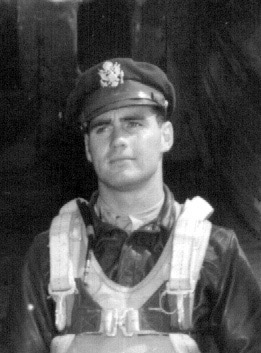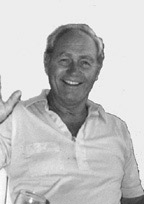All KIA Just Wasn’t So
By Allen Ostrom
The man had been listed by the 398th Bomb Group as having been killed in action as of September 12, 1944. He and all the others on the James Fields B-17 of the 602nd Squadron. All marked KIA.
They went down in the Baltic Sea after not one, but two encounters with German Fighters. Now, 55 years later, it turns out that Lyman N. Cranston, Jr. is alive and well and living in Florida. His name will NOT appear on the stained glass Memorial Window at Anstey, after all.
Lyman N. Cranston, Jr.
 |
 |
Cranston was the co-pilot on the Fields crew and his story of escaping death in the Baltic Sea, and his subsequent return to the United States comes under the heading of slightly incredible. And having played through this scenario without knocking over a mountain of Air Force paper work smacks of, “it just fell through the cracks”.
After almost 30 minutes in the frigid Baltic Sea, he was rescued by the Swedish Navy. His plane was downed by an ME 109 “just when we all thought we would make it safely to Sweden and internment”. He was pulled from the sea by his Swedish rescuers, along with Fields, badly bruised and missing a leg. “He was dead when they pulled him in.” said Cranston.
Only one other crewman was found. Navigator Goodrich White’s body washed up on shore near Trelleborg, on Sweden’s southern tip.
Reflecting on the loss of all his comrades after reaching shore, Cranston said to his rescuers, “And here I am still standing on grass.” Since that time, and in the ensuing years, “I tried to forget.”
What he was trying to forget was the entire mission to Brux, Czechoslovakia and the loss of his comrades, one of whom he had met only that morning. That would be bombardier Billy Gonser, who was finishing up his mission slate with the Fields crew.
It was one of those long, 10-hour flights, a roundabout way to reach a chemical plant on the German-Czech border. After World War II Brux and surrounding ‘Sudetenland’ was given back to the Czechs and the city is now called ‘Most’.
Three quarters of the way to the target, between Hamburg and Berlin, a Foche Wulf 190 made a quick pass at the 602 squadron. He hit Fields’ No. 1 engine, creating a windmill. Soon No. 2 began to fail and there was no way his Fortress could keep up. Some 60 miles from the Baltic Sea, Fields and Cranston opted to try for Sweden, another 60 miles over the water. Nuthampstead was almost 400 miles to the west.
White plotted a course for Trelleborg, near Malmo, and the fast-failing B-17 appeared on its way to safety. The Swedish coastline was in sight. Suddenly, the plane’s guns opened fire and at the same time the ship was rocked by an explosion, caught by an ME-109.
“We were immediately on fire and Fields rang the bail-out bell. I got to the front hatch and motioned for White to jump. He said, “go ahead” and so I jumped. At the same time I hit the water the plane also hit and exploded. It came in on fire at 45 degrees. Nobody still in the plane could have survived that crash.”
(See accompanying reports from the Swedish Navy as their ships sped to the downed B-17, less than two miles from the outer beacon off Trelleborg).
Cranston was treated at the Trelleborg hospital and later transferred to Falun, North of Stockholm. Here he was interned for over three months with many other Allied airmen who had similarly found refuge in neutral Sweden. (This ‘hospitality’ also included downed German airmen.)
Cranston’s return to England was accompanied via a clandestine airline operated by Norwegian explorer/pilot, Bernt Balchen, a USAF colonel. Huddled in the converted bomb bay of a B-24 with several other internees, Cranston was returned on December 23, 1944 with the station in a state of heightened activity related to the Battle of the Bulge taking place on the continent.
He had a brief meeting with Capt. E.D.Scott, who had assumed him to have been killed with the rest of the crew, as it was reported on the group Intelligence Report. All his personal belongings had been efficiently removed by squadron staff for subsequent shipment to his family.
He returned quickly to the U.S., where he “tried to forget.” Fields’ body was returned to his hometown after the war. White is buried at the Brittany Cemetery in France. The names of bombardier Gonser, engineer Edward Mullendore, radio operator Richard Goodman and gunners Marvin Leach, James Somers and George Van Luven are inscribed on the Wall of the Missing at Cambridge, England.
Printed in Flak News Volume 14, Number 1, Page(s) 1 & 8, Month Year
|







